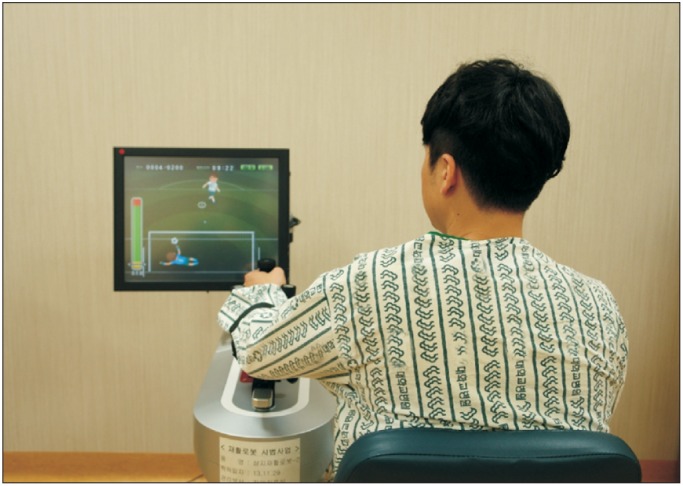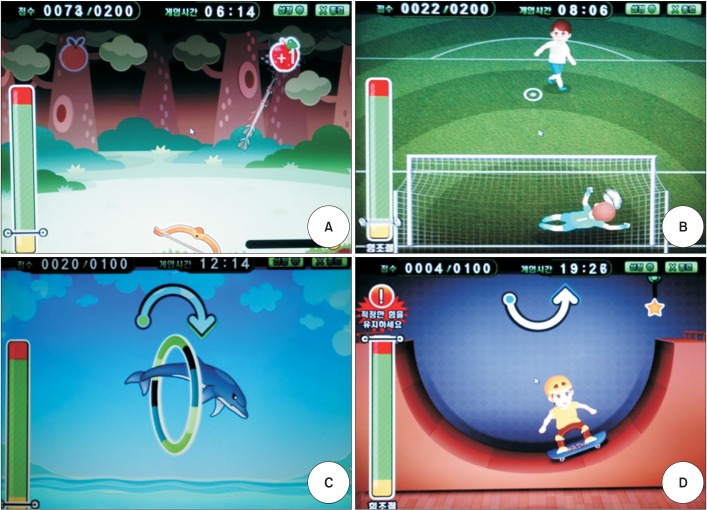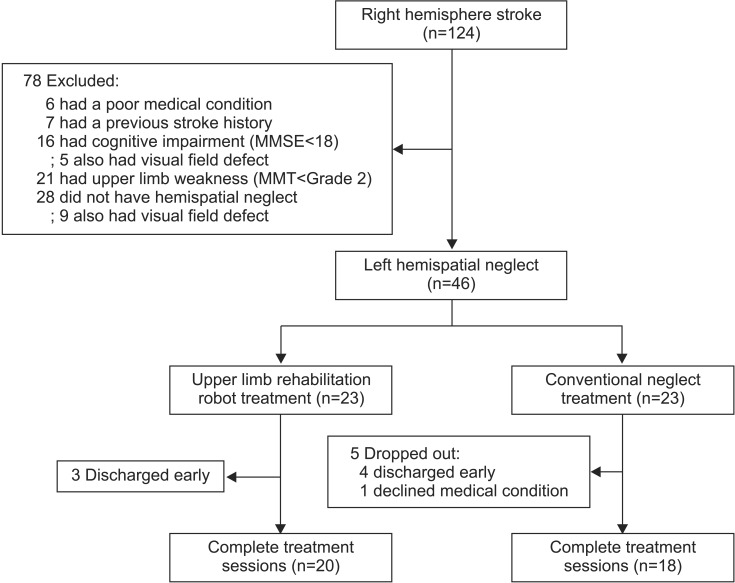Ann Rehabil Med.
2016 Aug;40(4):611-619. 10.5535/arm.2016.40.4.611.
The Effect of an Upper Limb Rehabilitation Robot on Hemispatial Neglect in Stroke Patients
- Affiliations
-
- 1Department of Physical Medicine and Rehabilitation, Dong-A University College of Medicine & Busan-Ulsan Regional Cardiocerebrovascular Center, Busan, Korea. lsj995414@hanmail.net
- KMID: 2356646
- DOI: http://doi.org/10.5535/arm.2016.40.4.611
Abstract
OBJECTIVE
To investigate the effectiveness of an upper limb rehabilitation robot therapy on hemispatial neglect in stroke patients.
METHODS
Patients were randomly divided into an upper limb rehabilitation robot treatment group (robot group) and a control group. The patients in the robot group received left upper limb training using an upper limb rehabilitation robot. The patients sat on the right side of the robot, so that the monitor of the robot was located on the patients' left side. In this position, patients could focus continuously on the left side. The control group received conventional neglect treatment, such as visual scanning training and range of motion exercises, administered by occupational therapists. Both groups received their respective therapies for 30 minutes a day, 5 days a week for 3 weeks. Several tests were used to evaluate treatment effects before and after the 3-week treatment.
RESULTS
In total, 38 patients (20 in the robot group and 18 in the control group) completed the study. After completion of the treatment sessions, both groups showed significant improvements in the Motor-Free Visual Perception Test 3rd edition (MVPT-3), the line bisection test, the star cancellation test, the Albert's test, the Catherine Bergego scale, the Mini-Mental State Examination and the Korean version of Modified Barthel Index. The changes in all measurements showed no significant differences between the two groups.
CONCLUSION
This present study showed that the upper limb robot treatment had benefits for hemispatial neglect in stroke patients that were similar to conventional neglect treatment. The upper limb robot treatment could be a therapeutic option in the treatment of hemispatial neglect after stroke.
Keyword
MeSH Terms
Figure
Cited by 1 articles
-
Effect of Combined Therapy of Robot and Low-Frequency Repetitive Transcranial Magnetic Stimulation on Hemispatial Neglect in Stroke Patients
Sang Beom Kim, Kyeong Woo Lee, Jong Hwa Lee, Sook Joung Lee, Jin Gee Park, Joung Bok Lee
Ann Rehabil Med. 2018;42(6):788-797. doi: 10.5535/arm.2018.42.6.788.
Reference
-
1. Luaute J, Halligan P, Rode G, Rossetti Y, Boisson D. Visuo-spatial neglect: a systematic review of current interventions and their effectiveness. Neurosci Biobehav Rev. 2006; 30:961–982. PMID: 16647754.
Article2. Ting DS, Pollock A, Dutton GN, Doubal FN, Ting DS, Thompson M, et al. Visual neglect following stroke: current concepts and future focus. Surv Ophthalmol. 2011; 56:114–134. PMID: 21335145.
Article3. Pierce SR, Buxbaum LJ. Treatments of unilateral neglect: a review. Arch Phys Med Rehabil. 2002; 83:256–268. PMID: 11833032.
Article4. Heilman KM, Valenstein E. Frontal lobe neglect in man. Neurology. 1972; 22:660–664. PMID: 4673341.
Article6. Damasio AR, Damasio H, Chui HC. Neglect following damage to frontal lobe or basal ganglia. Neuropsychologia. 1980; 18:123–132. PMID: 7383304.
Article7. Halligan PW, Marshall JC. Toward a principled explanation of unilateral neglect. Cogn Neuropsychol. 1994; 11:167–206.
Article8. Posner MI, Petersen SE. The attention system of the human brain. Annu Rev Neurosci. 1990; 13:25–42. PMID: 2183676.
Article9. Bailey MJ, Riddoch MJ, Crome P. Treatment of visual neglect in elderly patients with stroke: a single-subject series using either a scanning and cueing strategy or a left-limb activation strategy. Phys Ther. 2002; 82:782–797. PMID: 12147008.
Article10. Paolucci S, Antonucci G, Guariglia C, Magnotti L, Pizzamiglio L, Zoccolotti P. Facilitatory effect of neglect rehabilitation on the recovery of left hemiplegic stroke patients: a cross-over study. J Neurol. 1996; 243:308–314. PMID: 8965102.
Article11. Paolucci S, Traballesi M, Gialloreti LE, Pratesi L, Lubich S, Antonucci G, et al. Changes in functional outcome in inpatient stroke rehabilitation resulting from new health policy regulations in Italy. Eur J Neurol. 1998; 5:17–22. PMID: 10210807.
Article12. Rode G, Tiliket C, Boisson D. Predominance of postural imbalance in left hemiparetic patients. Scand J Rehabil Med. 1997; 29:11–16. PMID: 9084100.13. Kerkhoff G. Spatial hemineglect in humans. Prog Neurobiol. 2001; 63:1–27. PMID: 11040416.
Article14. Weinberg J, Diller L, Gordon WA, Gerstman LJ, Lieberman A, Lakin P, et al. Visual scanning training effect on reading-related tasks in acquired right brain damage. Arch Phys Med Rehabil. 1977; 58:479–486. PMID: 931586.15. Antonucci G, Guariglia C, Judica A, Magnotti L, Paolucci S, Pizzamiglio L, et al. Effectiveness of neglect rehabilitation in a randomized group study. J Clin Exp Neuropsychol. 1995; 17:383–389. PMID: 7650101.
Article16. Robertson IH, North N. Spatio-motor cueing in unilateral left neglect: the role of hemispace, hand and motor activation. Neuropsychologia. 1992; 30:553–563. PMID: 1641119.
Article17. Rossetti Y, Rode G, Pisella L, Farne A, Li L, Boisson D, Perenin MT. Prism adaptation to a rightward optical deviation rehabilitates left hemispatial neglect. Nature. 1998; 395:166–169. PMID: 9744273.
Article18. Frassinetti F, Angeli V, Meneghello F, Avanzi S, Ladavas E. Long-lasting amelioration of visuospatial neglect by prism adaptation. Brain. 2002; 125(Pt 3):608–623. PMID: 11872617.
Article19. Priftis K, Passarini L, Pilosio C, Meneghello F, Pitteri M. Visual scanning training, limb activation treatment, and prism adaptation for rehabilitating left neglect: who is the winner? Front Hum Neurosci. 2013; 7:360. PMID: 23847520.
Article20. Lo AC. Clinical designs of recent robot rehabilitation trials. Am J Phys Med Rehabil. 2012; 91(11 Suppl 3):S204–S216. PMID: 23080037.
Article21. Mazzoleni S, Sale P, Tiboni M, Franceschini M, Carrozza MC, Posteraro F. Upper limb robot-assisted therapy in chronic and subacute stroke patients: a kinematic analysis. Am J Phys Med Rehabil. 2013; 92(10 Suppl 2):e26–e37. PMID: 24052027.22. Kim J, Park SW, Lee Y, Seo H. Clinical outcomes of robot-assisted arm rehabilitation in stroke patients. Brain Neurorehabil. 2015; 8:46–52.
Article23. Kerkhoff G, Bucher L, Brasse M, Leonhart E, Holzgraefe M, Volzke V, et al. Smooth pursuit “bedside” training reduces disability and unawareness during the activities of daily living in neglect : a randomized controlled trial. Neurorehabil Neural Repair. 2014; 28:554–563. PMID: 24407913.24. Mercier L, Desrosiers J, Hebert R, Rochette A, Dubois MF. Normative data for the motor-free visual perception test-vertical. Phys Occup Ther Geriatr. 2001; 19:39–50.
Article25. Schenkenberg T, Bradford DC, Ajax ET. Line bisection and unilateral visual neglect in patients with neurologic impairment. Neurology. 1980; 30:509–517. PMID: 7189256.
Article27. Chen P, Hreha K, Fortis P, Goedert KM, Barrett AM. Functional assessment of spatial neglect: a review of the Catherine Bergego scale and an introduction of the Kessler foundation neglect assessment process. Top Stroke Rehabil. 2012; 19:423–435. PMID: 22982830.
Article28. Rizzolatti G, Berti A. Neglect as a neural representation deficit. Rev Neurol (Paris). 1990; 146:626–634. PMID: 2124720.29. Robertson IH, North NT, Geggie C. Spatiomotor cueing in unilateral left neglect: three case studies of its therapeutic effects. J Neurol Neurosurg Psychiatry. 1992; 55:799–805. PMID: 1402971.
Article30. Gainotti G, Perri R, Cappa A. Left hand movements and right hemisphere activation in unilateral spatial neglect: a test of the interhemispheric imbalance hypothesis. Neuropsychologia. 2002; 40:1350–1355. PMID: 11931938.
Article31. Brunila T, Lincoln N, Lindell A, Tenovuo O, Hamalainen H. Experiences of combined visual training and arm activation in the rehabilitation of unilateral visual neglect: a clinical study. Neuropsychol Rehabil. 2002; 12:27–40.
Article32. Masiero S, Carraro E, Ferraro C, Gallina P, Rossi A, Rosati G. Upper limb rehabilitation robotics after stroke: a perspective from the University of Padua, Italy. J Rehabil Med. 2009; 41:981–985. PMID: 19841828.
Article
- Full Text Links
- Actions
-
Cited
- CITED
-
- Close
- Share
- Similar articles
-
- Effect of Combined Therapy of Robot and Low-Frequency Repetitive Transcranial Magnetic Stimulation on Hemispatial Neglect in Stroke Patients
- Influence of Hemispatial Neglect on Trunk Control in Stroke Patients
- Correlation of Hemispatial Neglect with White Matter Tract Integrity: A DTI Study
- Number Processing Error as a Clinical Manifestation of Hemispatial Neglect Following Hypoxic Brain Injury:a Case Report
- Somatoparaphrenia in Patient with Posterior Cerebral Artery Infarction




